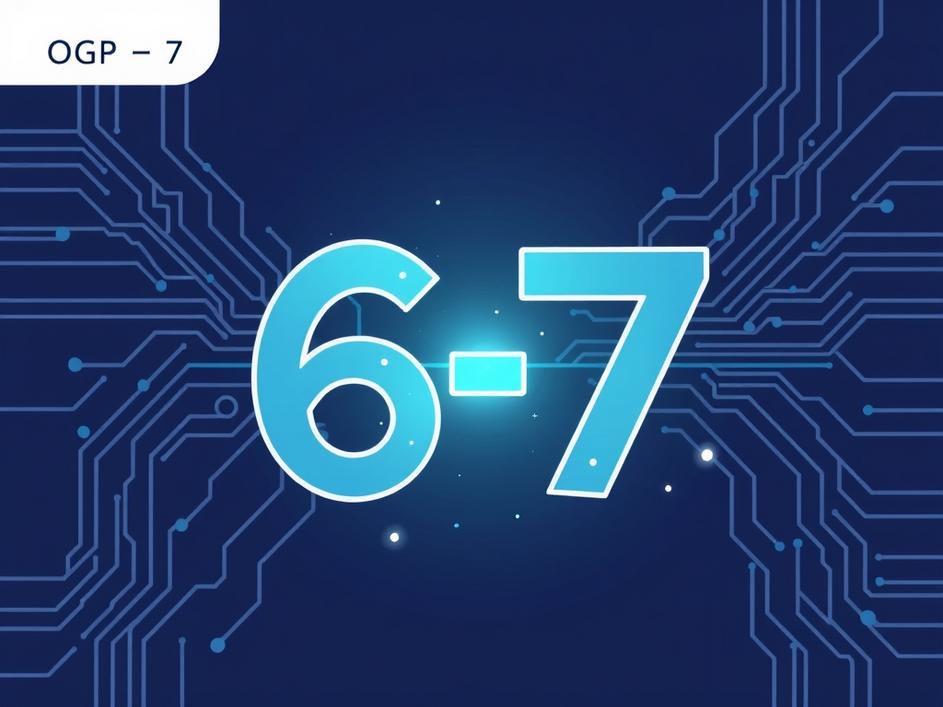


We are a digital agency helping businesses develop immersive, engaging, and user-focused web, app, and software solutions.
2310 Mira Vista Ave
Montrose, CA 91020
2500+ reviews based on client feedback

What's Included?
ToggleFor a long time, we’ve had a pretty straightforward understanding of how new software versions work. It’s simple, right? You get version 1, then 2, then 3, and so on. Sometimes there are little updates, like 3.1 or 3.5, but the main numbers tick up in a neat, orderly line. This system helps us keep track of progress, understand big leaps, and generally makes sense. But then, Sam Altman, the CEO of OpenAI, decided to throw a playful curveball into this predictable world. He dropped a short message on X (formerly Twitter) that instantly made everyone scratch their heads: “GPT-6 will be renamed GPT-6-7, you’re welcome.”
Just five words, plus a little emoji, and the internet was buzzing. What did it mean? Was it a joke? A typo? Or a sneaky peek into something much deeper about how OpenAI thinks about building its cutting-edge AI models? The reaction was immediate, a mix of amusement and genuine curiosity. People started guessing. Is it like a 6.5? Does it mean they’re skipping 7? Is it a combination of two models? The whole thing felt very characteristic of the fast-moving, sometimes unpredictable world of AI development, where even a simple name change can become a major talking point. It put the spotlight squarely back on OpenAI and made us all wonder what kind of magic they’re cooking up next.
While Sam Altman is known for his witty remarks and occasionally teasing the AI community, it’s hard to imagine such a prominent announcement being *just* a joke. So, if we look past the playful tone, what are some real possibilities for what ‘GPT-6-7’ could mean? One idea is that it represents a model that sits firmly between GPT-6 and GPT-7 in terms of capability. Think of it like a “6.5” but with a more definitive, almost hybrid, identity. Maybe OpenAI has achieved a significant leap from what they originally envisioned as GPT-6, pushing it so close to GPT-7’s expected performance that it doesn’t quite fit either label perfectly. It’s a bit like saying, “This isn’t just a souped-up 6, but it’s not the full future of 7 yet either.” The hyphen could literally mean “a bridge between.”
Another compelling thought is that it points to a new way of developing and releasing these massive AI systems. Perhaps it’s not a single, monolithic model but a combination of advanced techniques or even two distinct models working together so seamlessly that their combined power earns them a dual number. Imagine a core GPT-6 model enhanced by a “preview” or “satellite” version of GPT-7’s architecture. This kind of integration could offer unique capabilities that a standalone 6 or 7 wouldn’t. It’s also possible that OpenAI is experimenting with a continuous development cycle, where improvements are so constant that strict version numbers become less meaningful. In this scenario, “6-7” might mark a particular, very potent point along a spectrum of ongoing innovation, rather than a fixed, final release.
The traditional software world likes its clear version numbers. Microsoft Word 2007, then 2010, then 2013. Windows XP, then Vista, then 7. These are distinct products, often with noticeable changes between them. But AI development is different. It moves incredibly fast, with new breakthroughs happening all the time. Sometimes, a team might make a small tweak that has a huge impact. Other times, they might hit a wall on a planned feature for the next version, but discover something else amazing. This makes the idea of perfectly sequential, major version numbers feel a bit outdated for the bleeding edge of AI. We’re often seeing “frontier models” that are constantly getting better, sometimes daily. The “6-7” naming could be OpenAI’s way of acknowledging this fluid reality. It tells us that progress isn’t always a stair-step; sometimes it’s a ramp, and “6-7” is just a particularly exciting point on that ramp. It nudges us to think less about rigid versions and more about a continuous journey of improvement, where the lines between what’s “next” and what’s “now” are getting fuzzier.
From where I stand, this naming choice is more than just a clever marketing move, though it certainly got people talking. It reflects a deeper truth about the state of large language models right now. These models are becoming incredibly complex, and their development isn’t always a clean break between versions. It’s a constant pushing of boundaries, often resulting in capabilities that blur the lines between what was planned for “this” version and what’s being developed for “the next.” GPT-6-7 might be OpenAI’s honest way of saying, “We’ve built something that goes significantly beyond GPT-6, but it’s not quite the full, new paradigm shift we expect for a standalone GPT-7 yet. It’s in between, and it’s powerful.” This also tells us something about managing expectations. Instead of hyping up a “GPT-7” that might still be a long way off, they can deliver a substantial upgrade that bridges the gap, giving users a taste of the future sooner. It’s a practical, and perhaps even humble, approach to naming a truly advanced piece of technology in a world where AI progress doesn’t always fit into neat boxes.
So, what does GPT-6-7 mean for us, the users, or for the wider AI landscape? It likely means we’re in for another significant jump in AI capability, regardless of the hyphen. It means that OpenAI isn’t just sticking to the playbook; they’re willing to be creative, even whimsical, in how they present their advancements. And it means that the future of AI will continue to be full of surprises, not just in what these models can do, but also in how their creators choose to describe them. We might see more “in-between” versions, or completely new naming schemes, as AI continues its rapid evolution. The bottom line is that while the name itself is intriguing, the real excitement lies in the power and potential that GPT-6-7 will bring. We’re on an exciting, if sometimes confusing, journey with AI, and this little naming tweak is just another reminder of how wonderfully unpredictable it all is.



Leave a reply